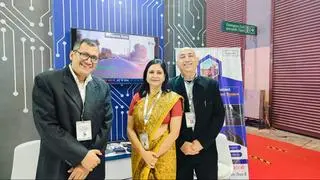Twenty-three-year-old Sahil Jakhar, known as ‘Soul Omega from Team Soul’ in the esports circuit, has raked in a cool $47,681 (nearly ₹40 lakh) over the last four years. What started off as a hobby for him is today his primary source of income.
“Having already competed in two official tournaments with substantial prize pools of crores of rupees, my team is currently gearing up for the third official Battlegrounds Mobile India (BGMI) tournament. The frequency and scale of these tournaments have made gaming a viable career option for me,” Jakhar says.
Like Jakhar, thousands of young Indians have made a career out of electronic sports — organised competitive video gaming for individual players and teams, involving cash prize. Government recognition, including the participation of an official Indian team in the newly inducted esports segment at the 19th Asian Games in Hangzhou (China) is believed to have added to the popularity of these digital contests, amassing a huge fan base in a country where gaming has long had a negative association with betting.
“The government’s recognition of esports has played a pivotal role in diminishing all stereotypes surrounding the sector and encouraging further growth,” says Lokesh Suji, Director of Esports Federation of India and Vice-President of Asian Esports Federation.
The 15-member Indian contingent at the Asian Games competed in four different title clashes, with the League of Legends team finishing impressively in fifth place.
Fan following
Game streaming, particularly on platforms like YouTube, Discord, and Twitch, has helped rack up the number of followers, alongside celebrity endorsements and match telecasts on mainstream platforms like Star Sports and JioCinema.
Tanushree Basu Roy, Researcher (India) at Statista, a market data portal, says average peak viewership for competitive esports in India touched two million in 2022 from 0.6 million in 2020. “Esports viewership is forecast to ascend further in the years to come,” she says.
Statista’s report projects three-million viewership and $3.1-billion valuation for the Indian esports segment. Lumikai, a venture capital fund focused on India’s gaming space, has projected $7.5-billion valuation for the sectory by the fiscal year 2028.
In fact, India has been touted as the fastest-growing video games market in Asia, with an estimated 444 million gamers by the end of 2023, according to the ‘India Games Market 2023’ report by Niko Partners, a research organisation focused on the video games market and consumers in Asia, West Asia and North Africa. Notably, 71.8 per cent of them have engaged with esports, it says.
The reasons are not far to see, says esports federation chief Suji. A burgeoning youth population, expanding access to fast and reliable internet connectivity, and affordable gaming-friendly smartphones are driving the exponential growth of esports in India, he reasons.
Brand value
Animesh Agarwal, Founder and CEO of esports consulting and talent agency 8Bit Creatives and S8UL, says India’s mobile-dominated gaming ecosystem is becoming an attractive space for investors. “Fuelled by high internet penetration and the rise of gaming content creators, we have witnessed a surge in the number of players, viewers, and tournaments. The gaming audience, largely composed of young and tech-savvy individuals, represents a dynamic demographic that has become increasingly attractive to brands seeking to engage with a vast and influential consumer base,” he says.
Pointing out that esports has grown in India despite the ban on Chinese apps and betting games, Akshat Rathee, Managing Director of Nodwin Gaming, a subsidiary of the games portal Nazara Technologies, says the explosive growth of esports viewership and the influencer economy is helping create a massive brand recall.
Brands and advertisers are waking up to the marketing opportunities inherent in esports tournaments.
“International games like Valorant, Free Fire, Dota, COD, Clash Royale, and FIFA have become household names in India, particularly among the younger demographic,” says Manesh Swamy, Chief Creative Officer of digital marketing company LS digital.
Bang for the buck
The prize pool is a major draw. Nodwin Gaming’s BGMI Masters Series 2, for instance, comes with a ₹2.1-crore prize pool; Kingfisher India Premiership offers ₹1 crore; and Valorant Challengers South Asia ₹1.16 crore.
According to a report by computer maker HP, gamers in India earn ₹6-12 lakh a year on average. The lucrative returns are enthusing more and more youngsters to turn into professional gamers, says Swamy. Nearly 52 per cent of active gamers now consider it their primary career, up from 33 per cent a year ago, according to HP’s ‘Gaming Landscape Study’.
“Esports tournaments not only provide an essential platform for players but also place India on the global radar alongside other leading markets. Sponsorships and partnerships contribute to larger prize pools and reach. They also open doors for higher foreign investment inflow,” says Statista’s Roy.
However, alongside the many wins are several significant challenges too. The ambiguity over the legality of real-money games has created confusion for digital platforms that organise esports tournaments. Similarly, the ban on popular Chinese gaming platforms such as PUBG has left players scrambling for alternatives. Agarwal also points to the underdeveloped infrastructure for PC and console gaming as significant pain points in India. The high cost of gaming equipment hinders access, especially given that global tournaments like the Asian Games feature titles across PC and console platforms, he says.
“The lack of a roadmap for talent development and creation of competitive platforms and other infrastructure hampers the long-term development of a gaming ecosystem in India. Addressing these issues is vital to ensure our athletes achieve glory on the global stage,” Agarwal says.











Comments
Comments have to be in English, and in full sentences. They cannot be abusive or personal. Please abide by our community guidelines for posting your comments.
We have migrated to a new commenting platform. If you are already a registered user of TheHindu Businessline and logged in, you may continue to engage with our articles. If you do not have an account please register and login to post comments. Users can access their older comments by logging into their accounts on Vuukle.